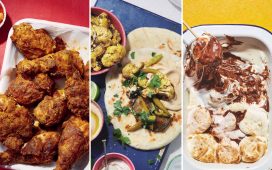All eating is an act of trust; when you eat fugu, it’s just that the stakes are higher. In Japan, it’s against the law to serve the fish without a license. Prerequisites vary by area, but in Tokyo, where the rules are among the strictest, two years of specialized training are required before you can take the tests: the first on paper, including pictures of different species (22 are deemed edible by the government, with torafugu, or tiger fugu, the most beloved), each with its own reservoirs of TTX to label, and the second a technical exhibition to show that you can properly gut the fish. First to go are the fins, mouth and tail, then you score down the sides, peel back the skin, turn out the entrails and cut off the eyes. Only once the flesh is clean can you cut the sashimi usuzukuri-style, into gossamer slices, wielding the fugu-hiki, a long, skinny, flexible knife with a blade ground thin that exists only for this purpose.
You have 20 minutes for this performance, according to the Tokyo chef and Japan cultural envoy Naoyuki Yanagihara, and if so much as a fleck of blood remains, you fail. Last year, fewer than half the candidates passed. It’s made even more difficult by the low quality of the fish used: Because top-of-the-line fugu is deemed too expensive to waste on novices, they must settle for specially designated “training fugu,” frozen and “almost rotting inside,” Yanagihara says, around $10 for a whole fish versus the prized live specimens that can go for as much as $100 a pound. “After I passed the test, I bought good fresh fugu, and it was so easy.” All the dangerous bits are locked in a box and later taken to the fish market and incinerated.
Since the prefectures started implementing licenses in 1948, the number of annual fugu poisonings has steadily dropped. (Fugu kimo — liver — was banned in 1983, although it’s reportedly still clandestinely available at some establishments on request, and those who seek it out are perhaps closer to the death-defiers of the Western imagination, like the Kabuki actor Bando Mitsugoro VIII, who is said to have eaten four servings of it in 1975 and did not live to tell the tale; his family won millions of yen in damages and the chef was convicted of negligence.) In 1965 there were 88 deaths; from the 1990s onward, they’ve numbered in the single digits. These are typically chalked up to people catching their own fish and preparing it at home, perhaps a little too breezily.
THE WESTERN UNDERSTANDING of fugu is not so much wrong as incomplete. The deadliness is inseparable from the allure, because it makes the preparation more difficult for the chef, and the final achievement all the greater. But in recent decades, a number of Japanese restaurants have started offering farmed rather than wild fugu — fish bred in underwater cages or in tanks onshore and fed a controlled diet, minus the small crustaceans infested with TTX-bearing bacteria that they eat at sea. As a result, such fish are today believed to be entirely toxin-free. Some scientists have disputed this, arguing that TTX may in fact be produced by glands within the fugu itself, but the marine toxin specialist Tamao Noguchi spent eight years testing more than 7,000 fugu from farms across Japan and found not a trace. Farmed fugu is not only safer but cheaper than wild fugu, turning what was once an aristocrat’s luxury into an attainable pleasure. Chain restaurants now abound, and diners might be invited to catch their own fugu from an aquarium in the dining room.
What then of fugu chefs and their years devoted to training? Has the art of preparing fugu — of quietly, methodically dividing death from delight — entered its own slow fade? We live at a moment when many regard binaries as a form of resistance: wild versus farmed; natural versus industrial; an individual, idiosyncratic restaurant versus a chain of infinitely replicable ones. In the wake of World War II, processed foods were embraced as salvation, auguring liberation for women (traditionally the family cooks) from hours of toil at the stove and a hoped-for end to hunger. As the British historian Rachel Laudan writes in her 2001 essay “A Plea for Culinary Modernism,” suddenly “the food of the elite” was widely available “at a price everyone could afford.” Decades later, the ill effects of an overindustrialized food supply are evident in the dramatic rise in obesity and diseases linked to the homogenization of our diet. As recipes are lost and cooking techniques forgotten, culinary diversity diminishes.
So with each advance in cooking technology has come a defiant retreat. In certain circles, the early 21st-century fanfare over, say, the microwaveable sponge cake has given way to the nurturing of sourdough starters, a pandemic pastime. “Craft can serve as a metaphor for an alternative set of cultural values and work practices in contrast to the dominant norm,” the American anthropologist Susan J. Terrio has written; it becomes an ideological stance, a way for people to assert themselves against an increasingly corporatized, monocultural world. Still, it takes a certain amount of privilege to indulge in nostalgia for a more labor-intensive time. Much of this longing is for an imagined past in which every task in the production of food was intentional and joyous, rather than a matter of necessity. Such work only earned the label “artisanal” when it became a choice.





